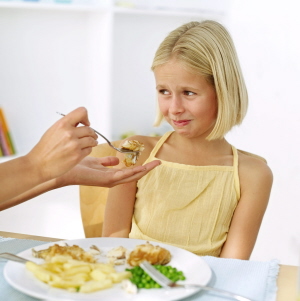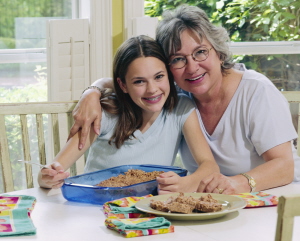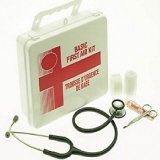|
Open Mind Tips on Healthy Eating For Kids

Open Mind, Healthy Eating for Kids The Basics Does This Mean I Can't Eat Ice Cream? Good nutrition does not mean that your children cannot eat
their favorite foods or that they must eat foods they do not
like. Good nutrition means variety and moderation in a person's
diet. Important Things To Know from Open Mind, Healthy Eating for Kids Nutrition and Your Child They went to the cupboard... Today, feeding children is
based on concerns about heart disease, diabetes, cancer, and
high blood pressure. There is reason to be concerned. More than
20 percent of children in the western world are overweight with a good chance that 50 to 70 percent of them will remain overweight as adults. It is important for parents to set good examples of healthful eating. 
You may think that breakfast is just another meal. For a child, breakfast provides much needed energy (calories) to start the day off right. Adults may be able to make up for skipped breakfast by grabbing something on the way to work or while doing morning errands. Your child, however, does not have that opportunity. A nursery school child usually has a mid-morning snack 3 to 5 hours after waking up. After kindergarten, few children are offered a morning snack. Getting your child to eat breakfast isn't always easy.Open Mind, Healthy Eating for Kids recommends you try to tune into your child's morning personality. A sleepyhead may need a quick breakfast. An early riser may like to eat breakfast before getting dressed. If this conflicts with your morning schedule, let your children get their own breakfast. Even a 6-year-old can open a container of yogurt.
A good breakfast consists of complex carbohydrates and simple sugars (breads, whole grains, fiber, fruits, and vegetables); proteins (dairy, chicken, beef, fish, eggs, nuts, and dried beans), and some fat. Carbohydrates and simple sugars offer quick energy but leave the stomach quickly. A breakfast of only carbohydrates can give a child the mid-morning "blahs". When milk, cheese, yogurt, lean meat, or an egg is added, the food stays in the stomach longer and provides sustained energy.

One way to get children to eat healthful food, especially vegetables, is to involve them in the selection and preparation of a recipe.
Open Mind, Healthy Eating for Kids-What to do
1. Choose a simple recipe to prepare. 2. Write a shopping list from the recipe. Check the nutritional value of the ingredients by reading the nutrition label aloud with your child. 3. Take the children to the market. The supermarket is the perfect place to introduce the older ones to label reading. For children over age 6, see who can find the products with the most sugars, fats, and salt. Explain that the first ingredient listed is what the food has the most of. Then, hunt for alternative, healthier foods. 4. Allow children to feel the weight and texture of vegetables. Handling hits and vegetables will help them learn how to distinguish between ripe, unripe, or spoiled produce. 5. Have children help you put away groceries. Preschoolers enjoy washing fruits and vegetables, and you can explain the proper way to wash them to remove dirt and insecticides. Have them store fresh vegetables in the refrigerator, explaining this will help retain vitamins and help the vegetables stay fresh longer. Have them store root vegetables (potatoes and onions) in a cool, dry place away from light. 6. Place all the ingredients you will need for the recipe on a tray to make cooking more efficient. 7. Keep tasks simple and within the child's abilities. Toddlers can stir an egg, mix ingredients, spread jams or peanut butter, or carry pots and pans. Older children love to measure dry ingredients and enjoy the challenge of pouring liquids without spilling.
Open Mind, Healthy Eating for Kids and Pediatricians recommend that parents should get more involved with their children. What better way than by making a game out of cooking, a necessary task but one in which everyone can be involved. Having your children participate in food selection can help you manage food choices for toddlers, pre-schoolers, and elementary school children.
Return to Food
|





 Open Mind, Healthy Eating for Kids suggests long-term good
Open Mind, Healthy Eating for Kids suggests long-term good 






